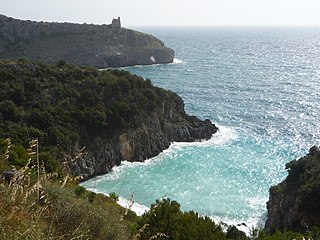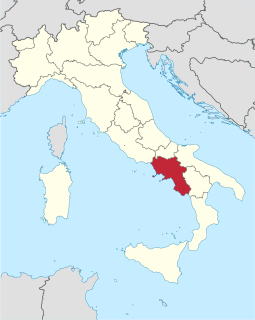 W
WThe Avellino eruption of Mount Vesuvius refers to a Vesuvian eruption in c. 1995 BC. It is estimated to have had a VEI of 6, making it larger and more catastrophic than Vesuvius's more famous and well-documented 79 AD eruption. It is the source of the Avellino pumice deposits extensively found in the comune of Avellino in Campania.
 W
WThe Campanian volcanic arc is a volcanic arc that consists of a number of active, dormant, and extinct volcanoes in the Campania region of Italy. The Campanian volcanic arc centers on the bay of Naples and includes:Mount Vesuvius: an active volcano that last erupted in 1944. Phlegraean Fields: a huge, ancient caldera containing the western area of Naples. The area is a collection of numerous extinct craters that are evidence of ancient eruptions; however, also included in this area is Solfatara, a shallow volcanic crater still emitting jets of sulfur fumes and, thus, still active. Mount Epomeo: 20 kilometres west of Naples on the island of Ischia, it last erupted in 1302. Palinuro, Vavilev, Marsili, and Magnaghi: undersea extinct or dormant volcanoes south of Vesuvius. The last three were discovered in the 1950s and bear the names of the geologists who discovered them. Palinuro was known earlier. As of 2006, there was some concern about the state of "dormancy" of Marsili, which is 3,000 meters high with the cone reaching to 500 meters from the surface of the water. Satellite cones of recent origin have been detected on Marsili.
 W
WThe Ciampate del Diavolo is a locality near the extinct Roccamonfina volcano in northern Campania, Italy. It is named after fossilised hominid footprints preserved in pyroclastic flow deposits that have been dated to around 350,000 years ago. They have been attributed to bipedal hominids, possibly Homo heidelbergensis, which is known to have inhabited the region at the time.
 W
WCilento is an Italian geographical region of Campania in the central and southern part of the Province of Salerno and an important tourist area of southern Italy.
 W
WCorricella is a port on Procida in the Phlegraean Islands off the coast of Naples in southern Italy. It is known for its vibrantly colorful housing.
 W
WIrpinia is a district of the Apennine Mountains around Avellino, a town in Campania, South Italy, about 50 km east of Naples. It was the territory of the ancient Hirpini tribe; its extent matches approximately today's province of Avellino.
 W
WThe following is a list of the communes of Campania, in Italy.
 W
WThe Metropolitan City of Naples is an Italian Metropolitan City in Campania region, established on January 1, 2015. Its capital city is Naples; within the city there are 92 comune (municipalities). It was first created by the reform of local authorities and established by the Law 56/2014, thus replacing the Province of Naples in 2015.
 W
WThe Naples metropolitan area, or Greater Naples, is a metropolitan area in Campania, Italy, centered on the city of Naples.
 W
WThe Silva Gallinaria is a rich thicket characterized by evergreen trees and shrubs typical of the Macchia Mediterranea, which grows naturally on a sandy and devoid of water. The most common tree that reigns unchallenged is the Quercus Ilex called also Holm Oak. This kind of jungle resumed the general characteristics of the Mediterranean Evergreen Forest but is distinguished for being contextualized in the Campania territory, specifically inside the area around Cuma - Licola - Liternum, and the historical baggage that inherits the early settlers of this coast: the Greeks, who founded the city of Cuma, which today form an acropolis.